Traffic is moderately heavy as I speed down the freeway, my eyes darting from the road ahead to the screen in the middle of my dashboard.

Data show 80% of accidents are caused by distracted driving, but if there's a collision in Ford's Distraction Lab, just hit "reset."
My task seems relatively simple: just find the address of a restaurant stored in my car’s navigation system and set is as my destination. But before I realize what’s happening, I’m about to slam into the car ahead. It’s a good thing it’s only a digital image on a virtual reality screen or I might be calling for a tow truck or worse, an ambulance.
Such a scenario shows just how dangerous the growing number of video screens in vehicles can be. Taken to its logical conclusion, automakers should be taking navigation systems out of cars. Precisely the opposite is happening of course, as they are are very profitable options.
A recent conference focused on the dangers of using cellphones to send text messages while driving. And there’s evidence that to simply make phone calls while you’re behind the wheel is the equivalent of drunk driving. But with the automobile becoming more and more the mobile equivalent of your living room or office there are plenty of other potential distractions that could lead to serious problems as well.
Which technology simply doesn’t belong? And how do you make seemingly mundane tasks, like finding a song on your car’s audio system, safer? That’s the goal of Ford Motor Company’s Human Machine Interface Verification Laboratory, otherwise known as the Distraction Lab.
Even the simple act of tuning a radio can be a distraction, notes Ford specialist John Shutko, a specialist in the way man and machine interact in a car. But texting has led to an “epidemic” of deaths, especially among young drivers. Studies show teens tend to have faster reflexes than older motorists, but they’re more likely to take their eyes off the road for longer periods of time.
That’s a major reason why car accidents have become the leading cause of death for teens. But data collected by the National Highway Traffic Safety Administration show that distracted driving is responsible for as much as 80% of all road accidents, whatever the driver’s age.
“If you take your eyes off the road for more than 20 seconds,” says Shutko, “it’s a risk.”
Ford’s Distraction Lab has come up with several novel ways to measure how much of a distraction different devices might create. In a large, darkened room, I’m invited to sit inside what looks a lot like a Ford Taurus sedan. But it’s a so-called “buck,” and all of its controls, including the steering wheel and pedals, are connected to a high-speed computer. On all the walls around me the system projects a digital reproduction of a real highway. A test subject can blast down the virtual road while taking all sorts of risk that will do nothing more than hurt one’s pride in the event of a digital accident.
Another, simpler system uses so-called “occlusion glasses.” Instead of conventional lenses, the goggles are equipped with small LCD screens that blink on and off in a carefully controlled sequence designed to imitate the time it takes to look away from the road, perform a task – like entering an address into a navigation system – then looking back up.
For even more sophisticated testing, Ford can turn to VIRTTEX, a virtual reality facility similar to the ones used to train airline pilots. The system not only projects life-like images on screens surrounding the “vehicle” inside the lab, but can move, much like an aircraft simulator, in any direction to simulate accelerating, braking — or the impact of an accident.
Ford research suggests that if 85% of the test subjects can complete a task in a set time – typically no more than a minute – it’s safe. If not, the equipment or the interface need to be redesigned.
That’s led Ford to re-think the way its new Sync system operates. Designers reduced the number of screens a driver might have to use to find and set a destination, for example.
It also encouraged designers to incorporate voice control technology, because “voice is the most efficient method. You don’t have to take your eyes off the road,” says Shutko. But sometimes, he admits, the Distraction Lab has produced some surprises. It can actually take some motorists an unexpectedly long time to use voice controls to dictate a 10-digit phone number.
While teens may take unnecessary risks with hi-tech devices, while behind the wheel. Older drivers are still more likely to be distracted by mundane tasks like tuning a radio, notes Shutko.
How much technology is too much technology for safe driving? That debate is likely to continue. Automakers clearly hope to find ways to expand their high-tech offerings, which help differentiate their products and produce hefty profit margins. But as the texting “crisis” has made clear, if you can’t keep your eyes on the road, you shouldn’t be driving. And maybe the answer is simple, disable all electronic devices if the vehicle is in motion.
